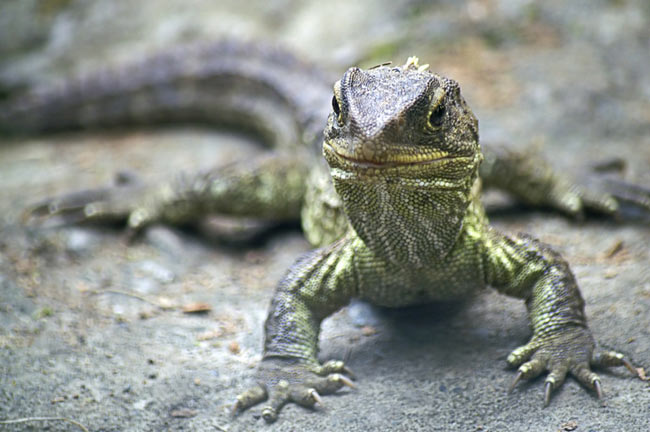Strange Reptile Chews Food With Steak Knife-Teeth

A strange reptile from New Zealand called the tuatara has some strange table manners. It uses its three rows of teeth in a unique way to chew its food much more than any other reptiles.
"Some reptiles such as snakes are able to swallow their food whole but many others use repeated bites to break food down," study researcher Marc Jones, of University College London, in the United Kingdom, said in a statement. "The tuatara also slices up its food, much like a steak knife."
Scientists thought that the only animals that chewed their food up so well were mammals. This new discovery shows it doesn't take a high metabolism, which mammals have and reptiles don't, to develop complex chewing.
"The slicing jaws of the tuatara allow it to eat a wide range of prey, including beetles, spiders, crickets and small lizards," Jones said. "There are also several grisly reports of sea birds being found decapitated following predation by tuatara."
The tough tuatara
The tuatara is a reptile from New Zealand that looks pretty much like an iguana. Interestingly, though it looks like most lizards, it belongs to a special grouping of animals in a different lineage called Sphenodontia. There are only two members of this group, which was widespread about 200 million years ago.
One really unique thing about these species is their teeth: Two rows of teeth on its upper jaw line up with one row on the lower jaw. The new research shows that these teeth make for a unique chewing method that overturns some previously held views on mastication (the fancy word for chewing).
Sign up for the Live Science daily newsletter now
Get the world’s most fascinating discoveries delivered straight to your inbox.
The researchers used a sophisticated computer model to show that when the Tuatara closes its mouth, its lower jaw rocks forward, turning each tooth into a steak knife, slashing through its food. The slight give in the connection between the jaws allows them to rotate, making the tearing action even more effective.
Mammal meat
This kind of thorough chewing is commonly found in warm-blooded animals like mammals (including humans). This new find indicates that warm-bloodedness and chewing aren't as closely linked as previously thought, since the tuataras are cold-blooded and have a slow metabolism.
"Because mammals show the most sophisticated form of chewing, chewing has been linked to high metabolism. However, the tuatara chews food in a relatively complex way but its metabolism is no higher than that of other reptiles with simpler oral food processing abilities," Jones said. "Therefore the relationship between extensive food processing and high metabolism has perhaps been overstated."
Extinct relatives of the tuatara probably had similar chewing mechanisms back to the time of the dinosaurs.
The study was published today (May 29) in the journal The Anatomical Record.
You can follow LiveScience staff writer Jennifer Welsh on Twitter, on Google+ or on Facebook. Follow LiveScience for the latest in science news and discoveries on Twitter and on Facebook.
Jennifer Welsh is a Connecticut-based science writer and editor and a regular contributor to Live Science. She also has several years of bench work in cancer research and anti-viral drug discovery under her belt. She has previously written for Science News, VerywellHealth, The Scientist, Discover Magazine, WIRED Science, and Business Insider.











